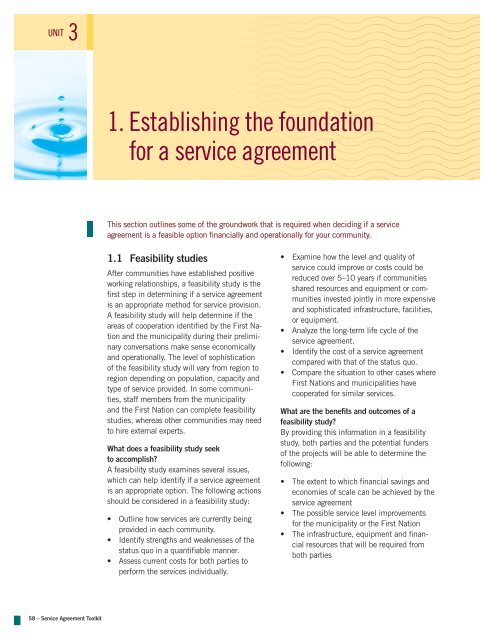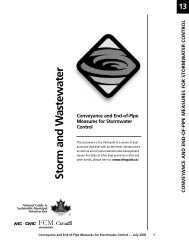Guide to Service Agreements - FCM
Guide to Service Agreements - FCM
Guide to Service Agreements - FCM
Create successful ePaper yourself
Turn your PDF publications into a flip-book with our unique Google optimized e-Paper software.
UNIT 3<br />
58 – <strong>Service</strong> Agreement Toolkit<br />
1. Establishing the foundation<br />
for a service agreement<br />
This section outlines some of the groundwork that is required when deciding if a service<br />
agreement is a feasible option financially and operationally for your community.<br />
1.1 Feasibility studies<br />
After communities have established positive<br />
working relationships, a feasibility study is the<br />
first step in determining if a service agreement<br />
is an appropriate method for service provision.<br />
A feasibility study will help determine if the<br />
areas of cooperation identified by the First Nation<br />
and the municipality during their preliminary<br />
conversations make sense economically<br />
and operationally. The level of sophistication<br />
of the feasibility study will vary from region <strong>to</strong><br />
region depending on population, capacity and<br />
type of service provided. In some communities,<br />
staff members from the municipality<br />
and the First Nation can complete feasibility<br />
studies, whereas other communities may need<br />
<strong>to</strong> hire external experts.<br />
What does a feasibility study seek<br />
<strong>to</strong> accomplish?<br />
A feasibility study examines several issues,<br />
which can help identify if a service agreement<br />
is an appropriate option. The following actions<br />
should be considered in a feasibility study:<br />
• Outline how services are currently being<br />
provided in each community.<br />
• Identify strengths and weaknesses of the<br />
status quo in a quantifiable manner.<br />
• Assess current costs for both parties <strong>to</strong><br />
perform the services individually.<br />
• Examine how the level and quality of<br />
service could improve or costs could be<br />
reduced over 5–10 years if communities<br />
shared resources and equipment or communities<br />
invested jointly in more expensive<br />
and sophisticated infrastructure, facilities,<br />
or equipment.<br />
• Analyze the long-term life cycle of the<br />
service agreement.<br />
• Identify the cost of a service agreement<br />
compared with that of the status quo.<br />
• Compare the situation <strong>to</strong> other cases where<br />
First Nations and municipalities have<br />
cooperated for similar services.<br />
What are the benefits and outcomes of a<br />
feasibility study?<br />
By providing this information in a feasibility<br />
study, both parties and the potential funders<br />
of the projects will be able <strong>to</strong> determine the<br />
following:<br />
• The extent <strong>to</strong> which financial savings and<br />
economies of scale can be achieved by the<br />
service agreement<br />
• The possible service level improvements<br />
for the municipality or the First Nation<br />
• The infrastructure, equipment and financial<br />
resources that will be required from<br />
both parties
















